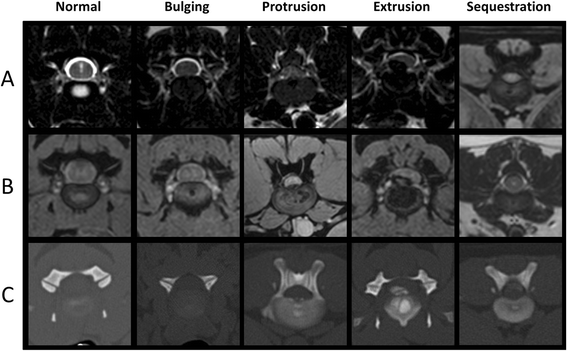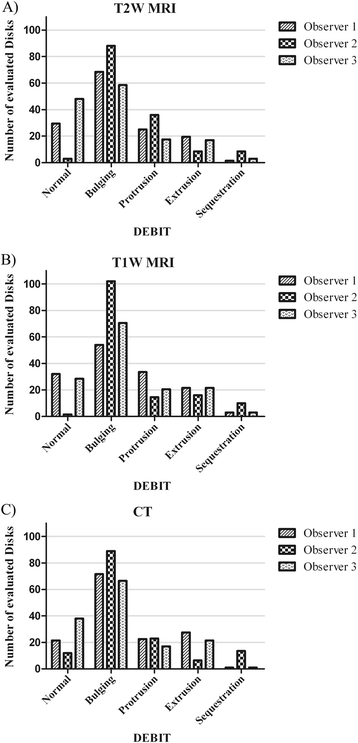"Disk extension beyond the interspace": an investigation into an alternative nomenclature in diagnostic imaging for displaced canine intervertebral disk material
- PMID: 25972009
- PMCID: PMC4436149
- DOI: 10.1186/s12917-015-0421-x
"Disk extension beyond the interspace": an investigation into an alternative nomenclature in diagnostic imaging for displaced canine intervertebral disk material
Abstract
Background: Displacement of canine intervertebral disk material can be seen directly in diagnostic imaging modalities such as magnetic resonance imaging and computed tomographic imaging. Canine intervertebral disk herniation can be differentiated into Hansen type 1 and 2 categories by clinical appearance, but anular- and nuclear disk material cannot be distinguished in computed tomographic images. Therefore, we hypothesized that the "Disk extension beyond the interspace"-nomenclature that describes the displacement by the disk contour might aid diagnosis. The aim of this study was to test the reliability of the "Disk extension beyond the interspace"-nomenclature in the evaluation of canine intervertebral disks via magnetic resonance and computed tomographic imaging.
Results: Magnetic resonance and computed tomographic images of 144 intervertebral disks of 43 dogs were evaluated by 3 observers with different degrees of experience from 2 institutions retrospectively. A substantial intraobserver agreement was found, while interobserver agreement was fair to moderate with significant differences in evaluation. Comparison of imaging methods showed a fair to moderate agreement without statistically significant differences in evaluation.
Conclusions: DEBIT-nomenclature cannot be recommended for veterinary clinical usage yet. The largest variability was found in the evaluation of the bulged canine intervertebral disk. The observers' experience and the imaging method influenced DEBIT- evaluation only slightly, while training and working at different institutions influenced DEBIT-evaluation strongly.
Figures


Similar articles
-
EVALUATION OF MAGNETIC RESONANCE IMAGING GUIDELINES FOR DIFFERENTIATION BETWEEN THORACOLUMBAR INTERVERTEBRAL DISK EXTRUSIONS AND INTERVERTEBRAL DISK PROTRUSIONS IN DOGS.Vet Radiol Ultrasound. 2016 Sep;57(5):526-33. doi: 10.1111/vru.12394. Epub 2016 Jul 4. Vet Radiol Ultrasound. 2016. PMID: 27374979
-
[Classification of canine intervertebral disc degeneration using high-field magnetic resonance imaging and computed tomography].Tierarztl Prax Ausg K Kleintiere Heimtiere. 2014;42(6):374-82. doi: 10.15654/TPK-140228. Epub 2014 Oct 6. Tierarztl Prax Ausg K Kleintiere Heimtiere. 2014. PMID: 25284617 German.
-
Intervertebral disc disease in dogs - part 2: comparison of clinical, magnetic resonance imaging, and histological findings in 74 surgically treated dogs.Vet J. 2013 Feb;195(2):164-71. doi: 10.1016/j.tvjl.2012.06.001. Epub 2012 Jul 12. Vet J. 2013. PMID: 22795604
-
Intervertebral disk degeneration in dogs: consequences, diagnosis, treatment, and future directions.J Vet Intern Med. 2013 Nov-Dec;27(6):1318-33. doi: 10.1111/jvim.12183. Epub 2013 Sep 6. J Vet Intern Med. 2013. PMID: 24010573 Review.
-
The canine intervertebral disk. Part Two: Degenerative changes--nonchondrodystrophoid versus chondrodystrophoid disks.J Am Anim Hosp Assoc. 1998 Mar-Apr;34(2):135-44. doi: 10.5326/15473317-34-2-135. J Am Anim Hosp Assoc. 1998. PMID: 9507426 Review.
Cited by
-
Usefulness of spinal unenhanced computed tomography and CT-myelography in the age of multidetector CT technology and magnetic resonance imaging - Preliminary considerations.Open Vet J. 2018;8(3):265-281. doi: 10.4314/ovj.v8i3.6. Epub 2018 Aug 5. Open Vet J. 2018. PMID: 30148079 Free PMC article. Review.
References
MeSH terms
LinkOut - more resources
Full Text Sources
Other Literature Sources
Medical

